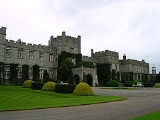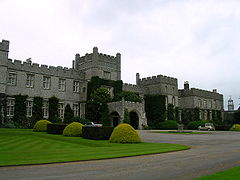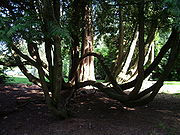
West Dean House
Encyclopedia

West Dean, West Sussex
West Dean is a village and civil parish in the District of Chichester in West Sussex, England located north of Chichester on the A286 road just west of Singleton. The parish includes the hamlets of Binderton and Chilgrove....
, near the historic City of Chichester
Chichester
Chichester is a cathedral city in West Sussex, within the historic County of Sussex, South-East England. It has a long history as a settlement; its Roman past and its subsequent importance in Anglo-Saxon times are only its beginnings...
. This country estate has approximately 6350 acres (25.7 km²) of land and dates back to 1086, with various royal connections throughout the years. In 1971 the Estate became the home of West Dean College
West Dean College
West Dean College is situated in the West Dean Estate, of West Dean near Chichester. The Estate was formerly the home of the poet and patron of the arts, Edward James. He was an avid admirer of the Surrealist movement, and formed one of the largest collections of their works during his lifetime...
, a centre of study of conservation, arts, crafts, writing, gardening and music.
The Medieval estate
The earliest known reference to the West Dean Estate is found in the Domesday BookDomesday Book
Domesday Book , now held at The National Archives, Kew, Richmond upon Thames in South West London, is the record of the great survey of much of England and parts of Wales completed in 1086...
in 1086, where it was included in the manor of Singletonas, a forest and hunting park. The Earls of Arundel and the Dukes of Norfolk held these lands for almost 500 years until 1572, when the 4th Duke of Norfolk was accused of treason. He was stripped of his possessions by Elizabeth the 1st and then beheaded . She later restored the properties and title to the Duke's eldest son Phillip. It was Phillip who built the first manor house at West Dean, West Sussex
West Dean, West Sussex
West Dean is a village and civil parish in the District of Chichester in West Sussex, England located north of Chichester on the A286 road just west of Singleton. The parish includes the hamlets of Binderton and Chilgrove....
in 1603, then known as Earl’s Court, later to be renamed Canon House due to its connections to Chichester Cathedral
Chichester Cathedral
The Cathedral Church of the Holy Trinity, otherwise called Chichester Cathedral, is the seat of the Anglican Bishop of Chichester. It is located in Chichester, in Sussex, England...
.
The Jacobean manor
In 1621 Phillip sold the manor and it passed into various ownerships, including the Sussex families of John Aylwin of Lewes and Richard Lewkenor of Stoughton. It was John Lewkenor in 1622 who built the Jacobean Manor house, on the site that was previously occupied by the medieval building. The building was built in an E-shape, common in the late 16th century.The Peachey family

Sir James Peachey, the 1st Lord Selsey, commissioned the leading architect of time, James Wyatt to rebuild the manor house, creating the core flint mansion seen at West Dean today. Wyatt is also responsible for the orangery on the West Dean estate.
James went on to gain a vast acreage of land, leaving it to his son, Sir John the second Lord Selsey on his death. John was responsible for laying out the parkland and arboretum in West Dean. All of John’s children were without heirs, so in 1871 the last Peachey died.
The James family
In 1891 West Dean became the home of newly married William Dodge James and Evelyn Forbes; William James was a wealthy land owner with money from American industries and Evelyn Forbes was the daughter of Sir Charles Forbes, a Scottish aristocrat.When James moved to the West Dean Estate in 1891, he set about altering and greatly extending the house and commissioned Ernest George
Ernest George
Sir Ernest George RA was an English architect, landscape and architectural watercolour painter, and etcher.-Life and work:...
and Harold Peto
Harold Peto
Harold Ainsworth Peto was a British landscape architect and garden designer, who worked in Britain and in Provence, France.-Biography:...
to do so. Ernest George
Ernest George
Sir Ernest George RA was an English architect, landscape and architectural watercolour painter, and etcher.-Life and work:...
helped embellish the state rooms and Harold Peto designed a 300 feet (91.4 m)-long pergola, still a highlight of the gardens today. West Dean House became one of the largest flint structures in the country. House parties at West Dean were attended by King Edward VII, Edward James’s Godfather. Edward VII was a regular participant of pheasant and partridge shoots on the West Dean estate. The interior of the house reflects William and his brothers Frank and Arthur’s, passion for big game hunting, with souvenirs of their visits to Africa, Arabia and Afghanistan displayed throughout the house.
William and Evelyn had five children, four girls, Millicent, Alexandra, Silvia and Audrey. In 1907, after 18 years of marriage, their son and heir Edward James was born.
Edward James
Edward JamesEdward James
Edward William Frank James was a British poet known for his patronage of the surrealist art movement.-Early life and marriage:...
was born on 16 August 1907, the only son of William James, an American railroad magnate who moved to England and married Evelyn Forbes, a Scots socialite, who was reputedly fathered by the Prince of Wales
Prince of Wales
Prince of Wales is a title traditionally granted to the heir apparent to the reigning monarch of the United Kingdom of Great Britain and Northern Ireland and the 15 other independent Commonwealth realms...
(later Edward VII). He had four older sisters: Audrey, Millicent, Xandra, and Silvia. James was educated briefly at Eton
Eton College
Eton College, often referred to simply as Eton, is a British independent school for boys aged 13 to 18. It was founded in 1440 by King Henry VI as "The King's College of Our Lady of Eton besides Wyndsor"....
, and then at Le Rosey
Institut Le Rosey
Institut Le Rosey, commonly referred to as Le Rosey or simply Rosey, is a school, in Gstaad, Switzerland. It is described as one of the most prestigious boarding schools in the world. The school was founded by Paul-Émile Carnal in 1880 on the site of the 14th-century Château du Rosey near the town...
in Switzerland, followed by Christ Church, Oxford
Christ Church, Oxford
Christ Church or house of Christ, and thus sometimes known as The House), is one of the largest constituent colleges of the University of Oxford in England...
, where he was a contemporary of Evelyn Waugh
Evelyn Waugh
Arthur Evelyn St. John Waugh , known as Evelyn Waugh, was an English writer of novels, travel books and biographies. He was also a prolific journalist and reviewer...
and Harold Acton
Harold Acton
Sir Harold Mario Mitchell Acton CBE was a British writer, scholar and dilettante perhaps most famous for being wrongly believed to have inspired the character of "Anthony Blanche" in Evelyn Waugh's novel Brideshead Revisited...
. In 1912 he inherited the 8000 acres (32.4 km²) West Dean House in Sussex
Sussex
Sussex , from the Old English Sūþsēaxe , is an historic county in South East England corresponding roughly in area to the ancient Kingdom of Sussex. It is bounded on the north by Surrey, east by Kent, south by the English Channel, and west by Hampshire, and is divided for local government into West...
, on the death of his father. He was only aged 4 at the death of his father in March of that year; however Edward did not take control of the Estate until he was 25.
James' first sponsorship of note was in publishing John Betjeman
John Betjeman
Sir John Betjeman, CBE was an English poet, writer and broadcaster who described himself in Who's Who as a "poet and hack".He was a founding member of the Victorian Society and a passionate defender of Victorian architecture...
's first book of poems when at Oxford. He worked with Brian Howard on the Glass Omnibus. After Oxford, James had a brief career as a trainee diplomat at the embassy in Rome
Rome
Rome is the capital of Italy and the country's largest and most populated city and comune, with over 2.7 million residents in . The city is located in the central-western portion of the Italian Peninsula, on the Tiber River within the Lazio region of Italy.Rome's history spans two and a half...
. He was asked to send a coded message to London that the Italians had laid the keels for three destroyers, but got the code wrong; the message said "300 destroyers". Shortly after this he was sent "on indefinite leave". After studying at Eton
Eton College
Eton College, often referred to simply as Eton, is a British independent school for boys aged 13 to 18. It was founded in 1440 by King Henry VI as "The King's College of Our Lady of Eton besides Wyndsor"....
and Oxford
Oxford
The city of Oxford is the county town of Oxfordshire, England. The city, made prominent by its medieval university, has a population of just under 165,000, with 153,900 living within the district boundary. It lies about 50 miles north-west of London. The rivers Cherwell and Thames run through...
, Edward tried to establish himself as a writer and poet. He became more famous being a patron to the arts, particularly the Surrealist movement. The first example of this was when Edward established the ‘James Press’ and published friend John Betjemen’s first book of poems, ‘Mount Zion’. Edward went on to support various other artists in a wide variety of arts, but particularly artists Salvador Dali
Salvador Dalí
Salvador Domènec Felip Jacint Dalí i Domènech, Marquis de Púbol , commonly known as Salvador Dalí , was a prominent Spanish Catalan surrealist painter born in Figueres,Spain....
and Rene Magritte
René Magritte
René François Ghislain Magritte[p] was a Belgian surrealist artist. He became well known for a number of witty and thought-provoking images...
during the early stages of their careers. He commissioned many pictures from those artists, which formed the nucleus of what became one of the largest collections of surrealist works in the world.
In the early 1930s, James married Tilly Losch
Tilly Losch
Ottilie Ethel Leopoldine "Tilly" Losch, Countess of Carnarvon was an Austrian-born dancer, choreographer, actress and painter who lived and worked for most of her life in the United States and United Kingdom....
, an Austrian dancer choreographer, actress and painter. He had several productions created expressly for her, the most notable of which was Les Ballets 1933, which included Kurt Weill
Kurt Weill
Kurt Julian Weill was a German-Jewish composer, active from the 1920s, and in his later years in the United States. He was a leading composer for the stage who was best known for his fruitful collaborations with Bertolt Brecht...
, Lotte Lenya
Lotte Lenya
Lotte Lenya was an Austrian singer, diseuse, and actress. In the German-speaking and classical music world she is best remembered for her performances of the songs of her husband, Kurt Weill. In English-language film she is remembered for her Academy Award-nominated role in The Roman Spring of Mrs...
and George Balanchine
George Balanchine
George Balanchine , born Giorgi Balanchivadze in Saint Petersburg, Russia, to a Georgian father and a Russian mother, was one of the 20th century's most famous choreographers, a developer of ballet in the United States, co-founder and balletmaster of New York City Ballet...
. He and Boris Kochno
Boris Kochno
Boris Kochno was a Russian poet, dancer and librettist. He was close with Karol Szymanowski who gave him as a gift a Russian translation of the chapter The Symposium from Efebos, the composer's unpublished novel. Szymanowski also dedicated four poems to him...
commissioned that year Brecht
Bertolt Brecht
Bertolt Brecht was a German poet, playwright, and theatre director.An influential theatre practitioner of the 20th century, Brecht made equally significant contributions to dramaturgy and theatrical production, the latter particularly through the seismic impact of the tours undertaken by the...
and Weill's
Kurt Weill
Kurt Julian Weill was a German-Jewish composer, active from the 1920s, and in his later years in the United States. He was a leading composer for the stage who was best known for his fruitful collaborations with Bertolt Brecht...
last collaboration, The Seven Deadly Sins, which Balanchine produced, directed and choreographed.
In 1939 Edward James wrote to Aldous Huxley
Aldous Huxley
Aldous Leonard Huxley was an English writer and one of the most prominent members of the famous Huxley family. Best known for his novels including Brave New World and a wide-ranging output of essays, Huxley also edited the magazine Oxford Poetry, and published short stories, poetry, travel...
expressing his fear that after the war, certain arts, and particularly the techniques of the craftsmen would be lost. As a solution James suggested that his Estate be set up as an educational community where the techniques of craftsmanship could be preserved and taught, whilst restoring old work and creating new art works.
In 1956 Wispers School
Wispers School
Wispers School was a British independent boarding school for girls aged between 11 and 18 which was founded in 1947 and which closed in 2008 after 61 years' operation...
, an independent boarding school for girls aged between 11 and 18, moved to West Dean House. In 1964 James gave the House to a charitable trust, The Edward James Foundation, but the school was able to remain at West Dean until 1968.
West Dean College
The Edward James Foundation was established in 1964 as a charitable, educational trust which supports and teaches artists and craftsmen and in 1971 the Foundation established West Dean College which offers full-time and short courses.Since the House became a college, extensive alterations and additions have been made to the bedrooms and former service areas of the house, in order to make it suitable for students. Roofing over the former stable yard and the surrounding buildings has enabled arts and crafts workshops to be built. All the work took place over a period of 20 years by architect John Warren, who tried to retain the historical features of the house.
The West Dean estate
The West Dean Estate has approximately 6350 acres (25.7 km²) of land. The Estate has 136 houses and cottages, as well as more than 100 farm buildings; some are occupied by the staff of the Estate and College, as well as by pensioners of the Foundation and local families.There are twelve farms on the Estate, many of which have been owned by the estate for generations. Seven of these farms are let and the other five are farmed through the Estate’s farming company, Karova Farms Ltd (named by Edward James), and their agricultural activates are split between livestock and cereals.
The woodlands comprise around 1932 acres (7.8 km²) of the estate, the main tree species being the native beech, found on the South Downs. The woodlands were badly affected by the storms of 1987 and 1990, and the woodland took over a decade to recover. The woodlands have become increasingly important, particularly when it became the key fuel to provide heating for the Estate in the 1970s. After the old boilers and electric heater proved to be incapable with dealing with the need from the evergrowing West Dean College, other methods were looked into, and wood fuel appeared to be the best alternative and the most eco friendly. 1,200 tonnes of wood chipping is needed to supply not only West Dean College, but several other residences on the estate as well, including the village church. The woodland also conceals a rich heritage with sites like Goosehill Camp
Goosehill Camp
Goosehill Camp is a prehistoric earthwork that dates back to the Iron Age. It consists of two concentric banks and ditches. The inner enclosure has one entrance and surround two levelled hut sites. Goosehill Camp is within the Kingley Vale National Nature Reserve, on the South...
dating back to the Iron Age
Iron Age
The Iron Age is the archaeological period generally occurring after the Bronze Age, marked by the prevalent use of iron. The early period of the age is characterized by the widespread use of iron or steel. The adoption of such material coincided with other changes in society, including differing...
.

